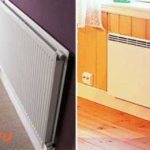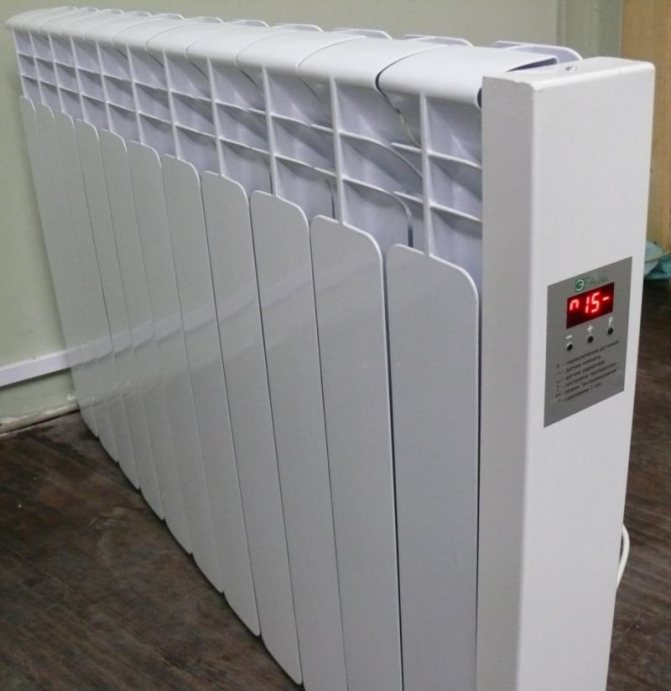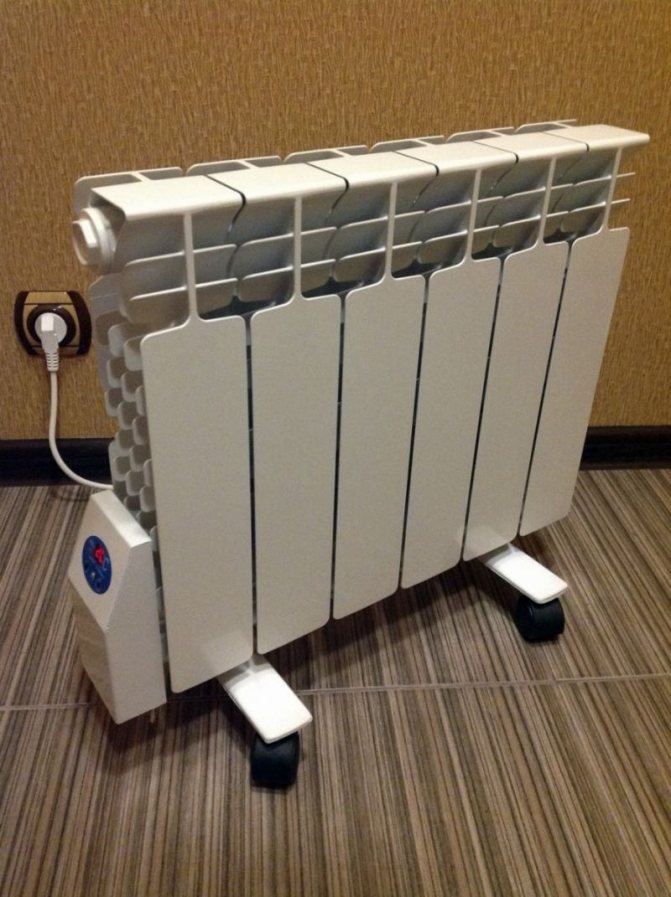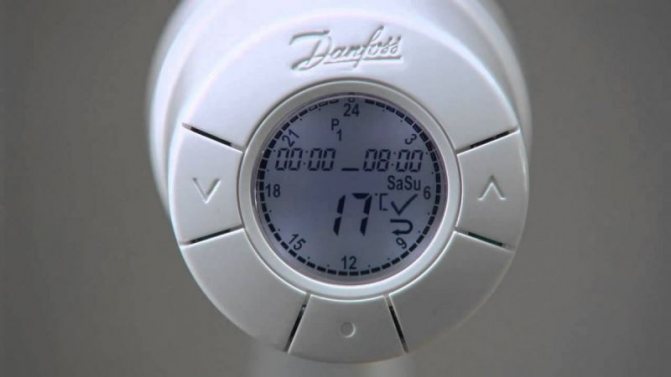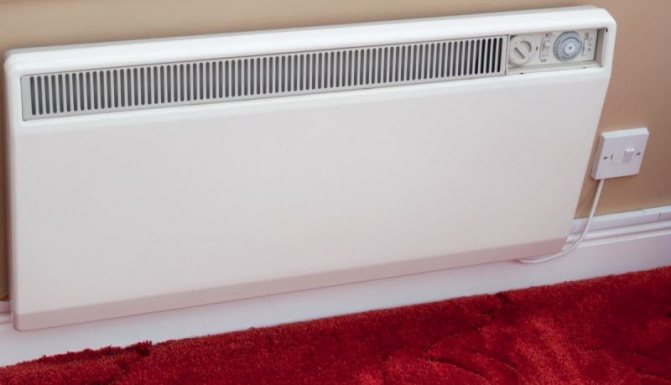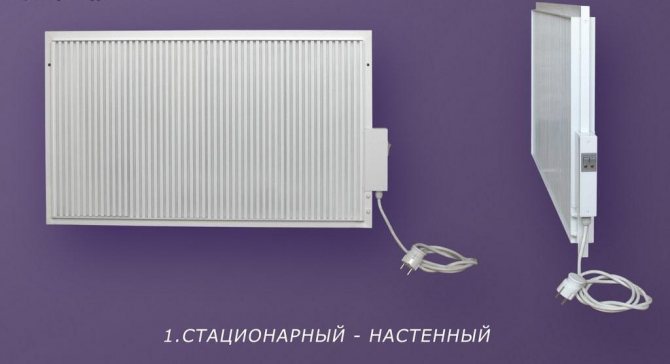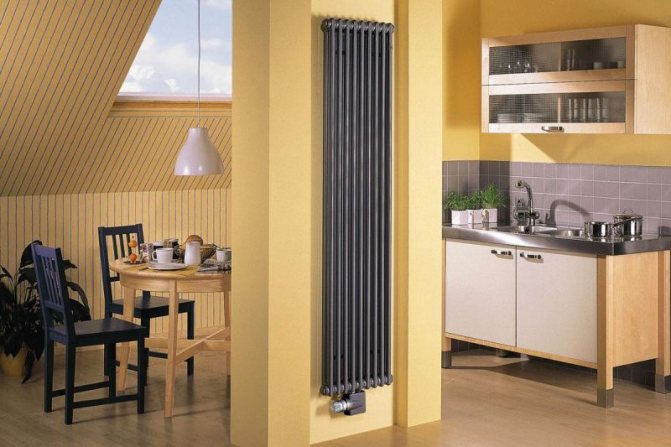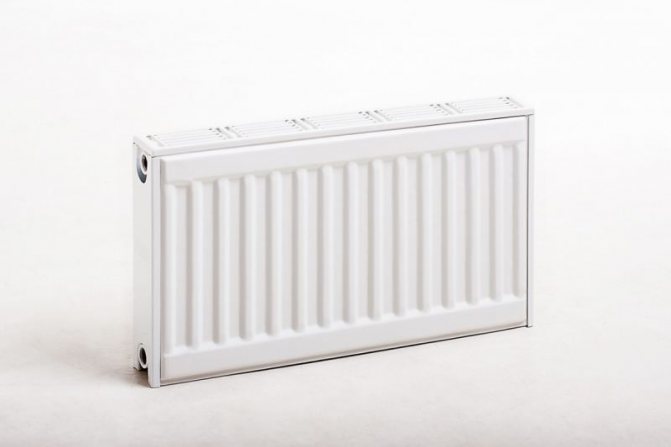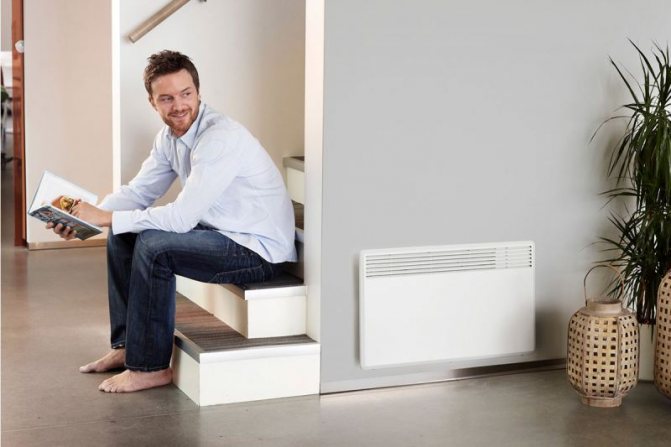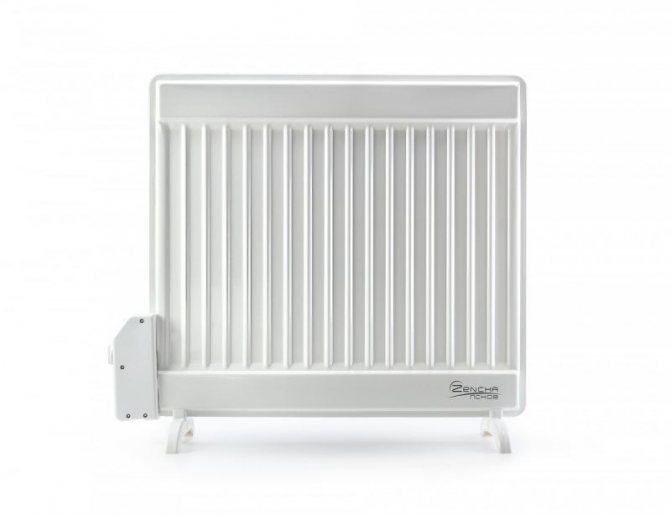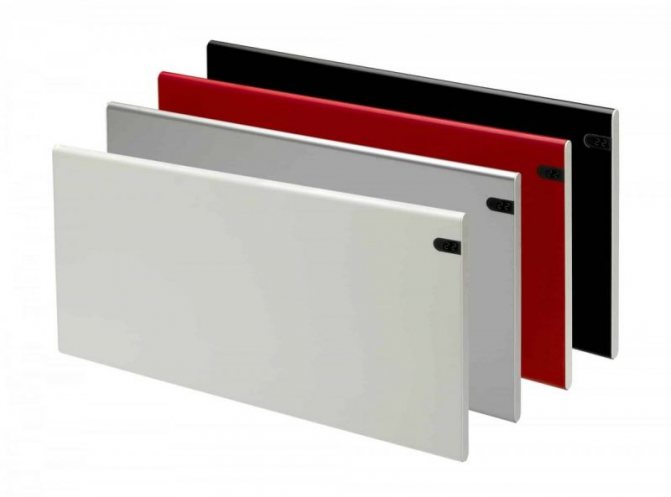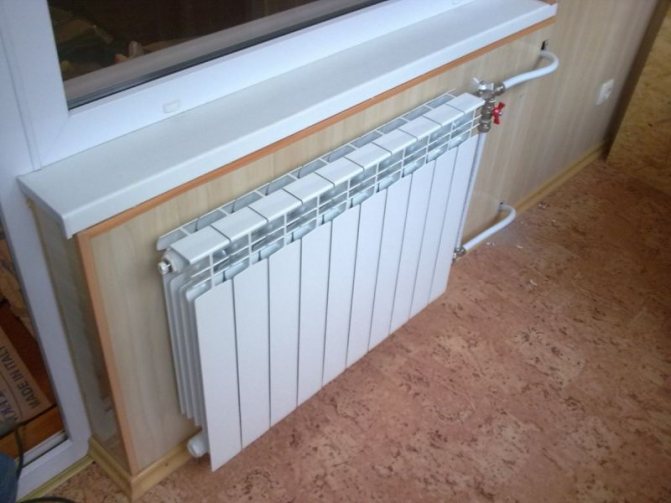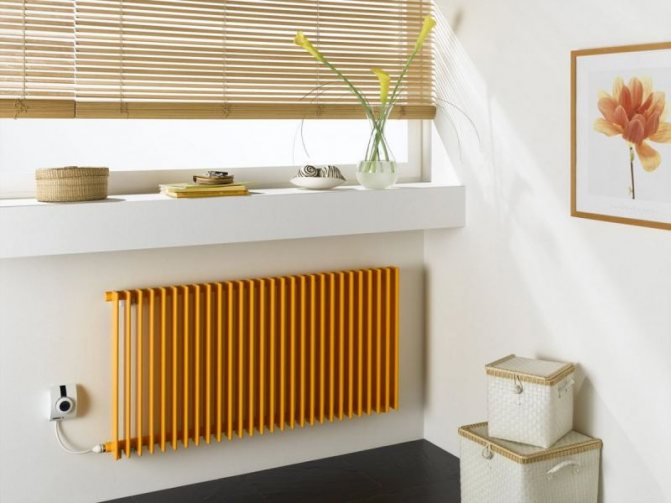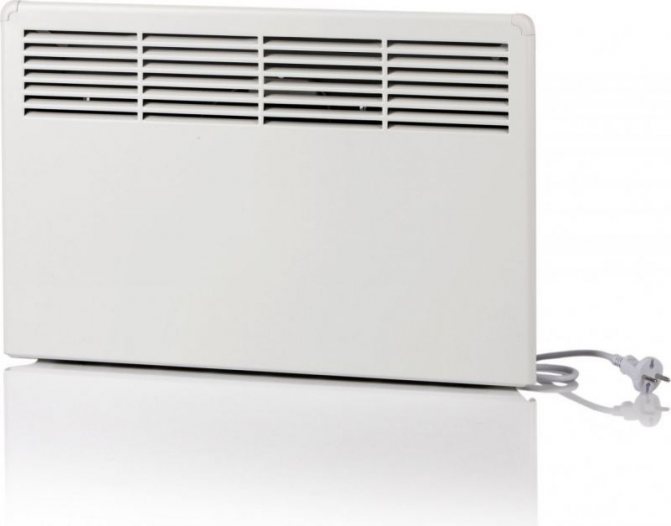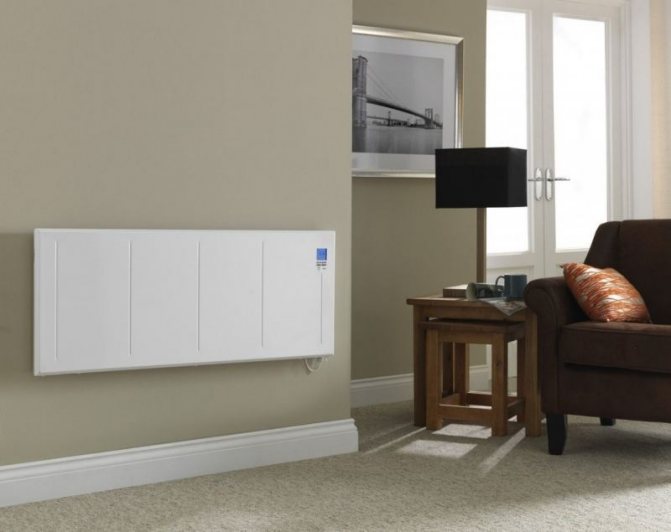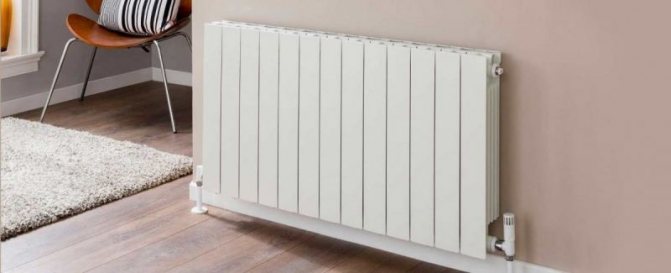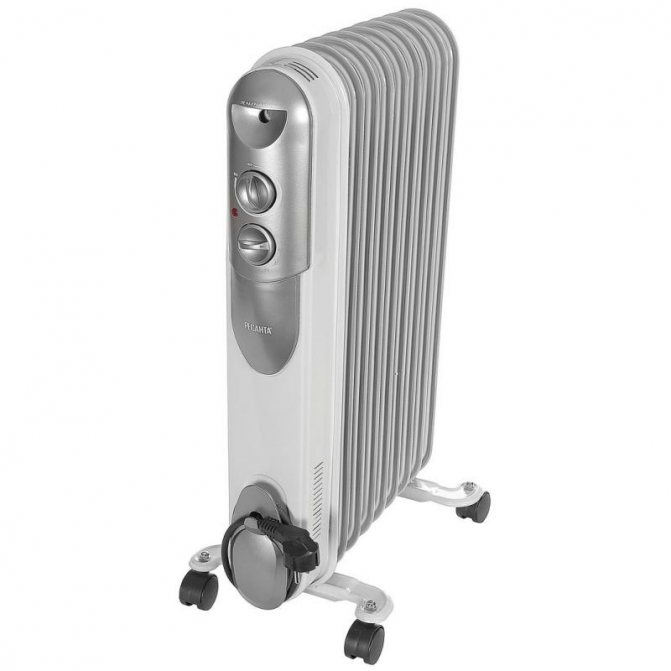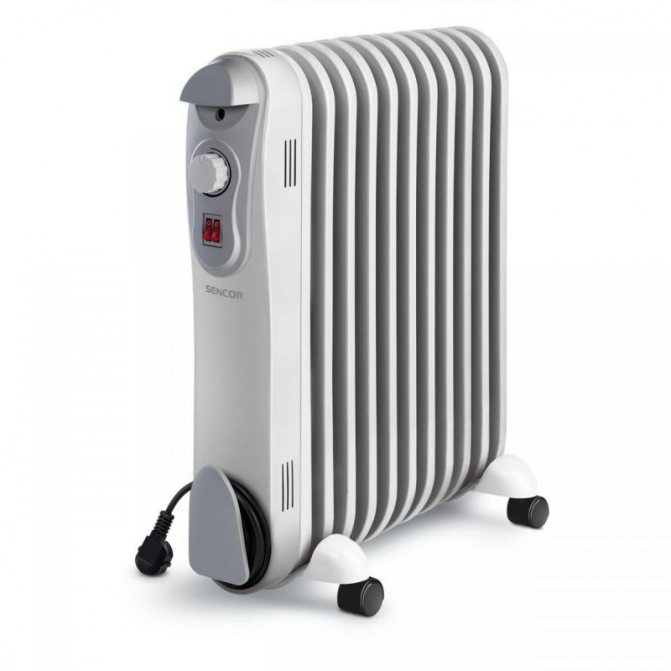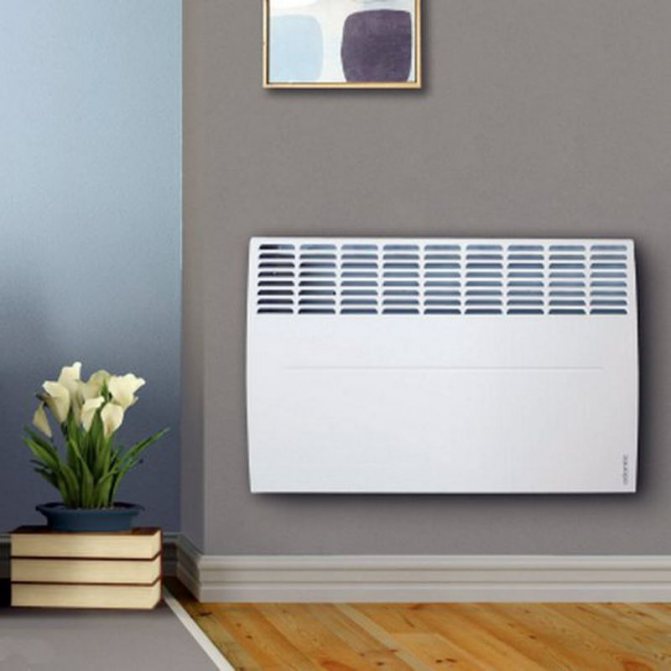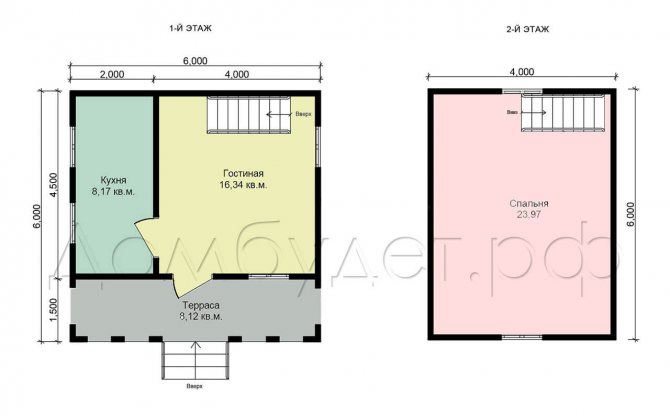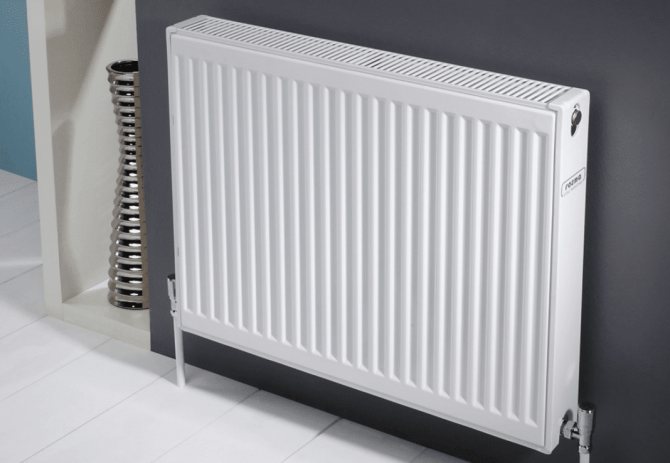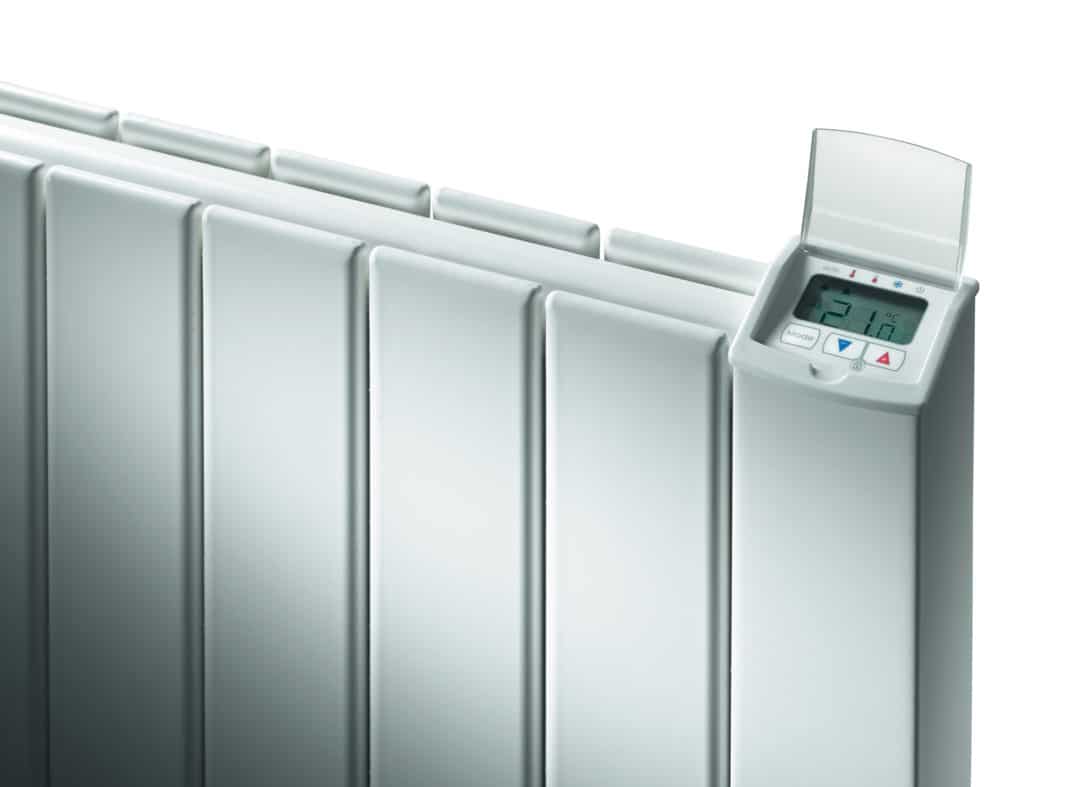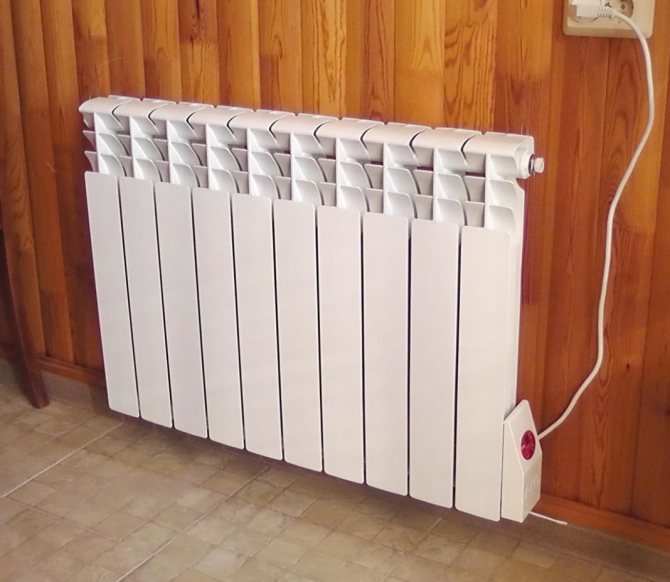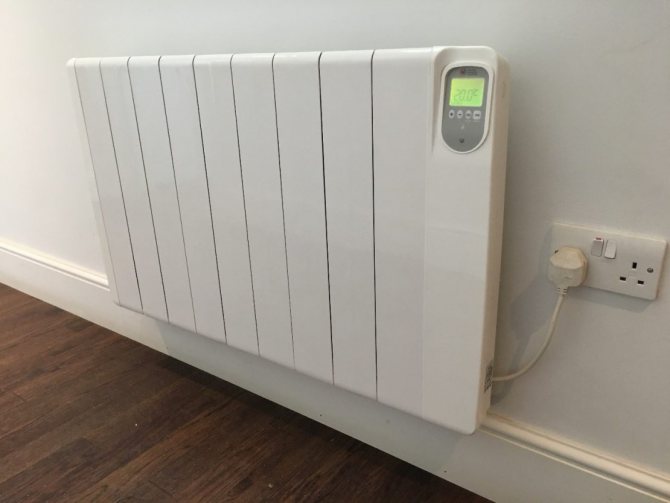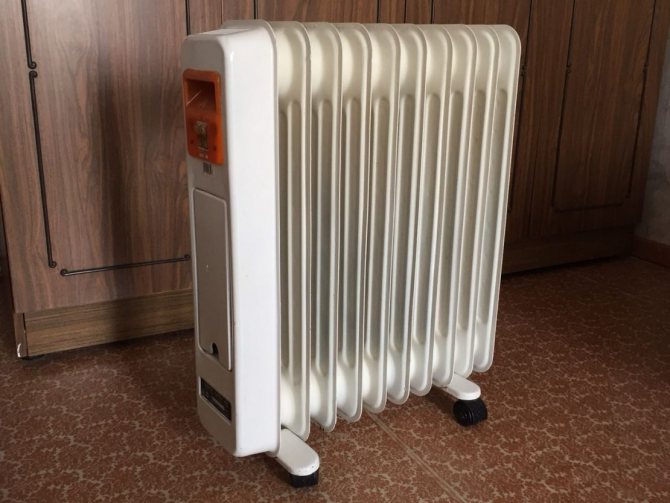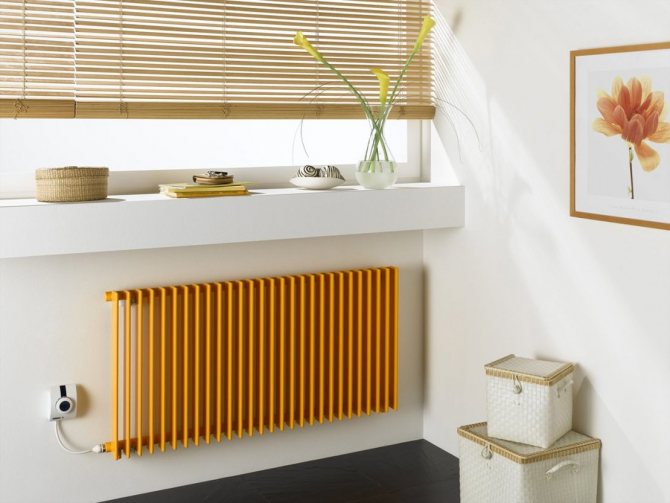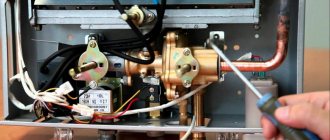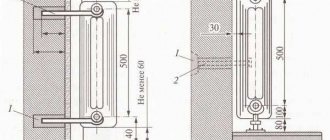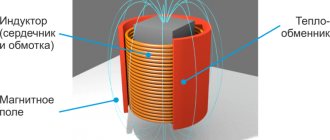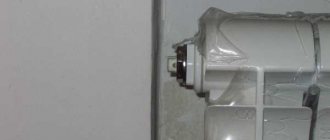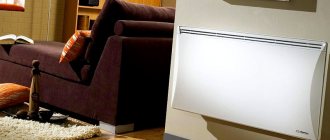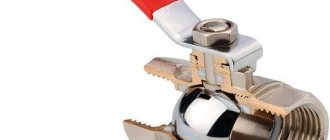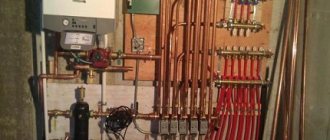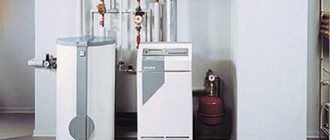Wall mounted electric heaters of oil type
Oil-type wall-mounted electric heaters have a sealed body made of steel, which contains mineral oil and a tube-type electric heater. They work according to an extremely simple principle: hot oil heats up the metal, and the heat energy emitted by it gradually heats the air and the wall. Heat is reflected from the wall and spreads throughout the room.
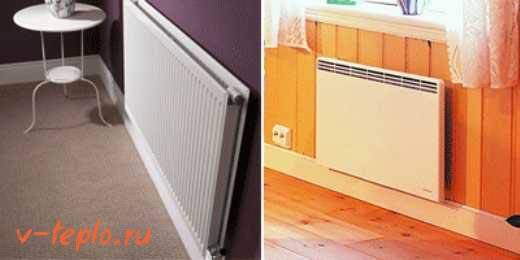
Almost everyone knows about these devices. They are characterized by a long service life, affordable cost and noiselessness. The body of this device does not get hot, therefore, it dries up the air in the same way as simple water batteries, but no more.
Of course, they also have disadvantages, including an impressive weight, which makes installation difficult for some types of partitions, as well as the fact that the room heats up rather slowly. It is undesirable to install oil-type devices in bathrooms, as well as leave them in country houses without use.
Energy saving option
The most economical option may be "Heat curtain"that is hung on the wall. It consumes a minimum of electricity and quickly heats up the air, which can significantly reduce the time of use.
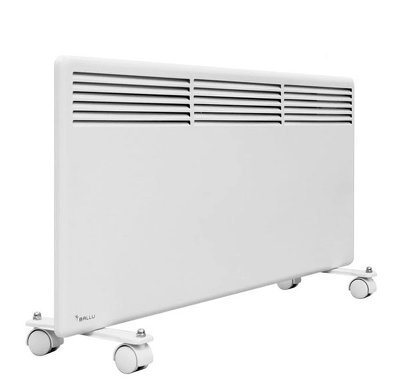

Also, this type of battery has a heat regulator.
When the room warms up to a certain temperature, the curtain turns off automatically, which will lead to savings.
If we refer to the types of radiators, then to the most compact, convenient and cheap options include convectors.
They have a lot of power, they quickly heat even a large room.
However, such equipment is inexpensive and does not consume more energy.
Reference! IN both cases you will save on installation, since an experienced specialist will charge you a large sum, although the installation of equipment is relatively easy... Having figured out the instructions, you can install the battery yourself.
How vacuum electric batteries work
Vacuum radiators are a more economical option in comparison with oil-filled electric batteries. Their work is based on the heating of a special liquid. located in the lower part of the aluminum case, easily evaporating and quickly spreading heat over the surface of the device. A feature of the liquid filling a vacuum electric battery is a low boiling point - only 35 degrees C and a small volume - 500 ml.
The heat transfer of a vacuum electric battery is quite large - about 300 W for each section. When the battery is disconnected, it retains heat for a long time. gas particles in a vacuum continue to move, albeit somewhat slower.
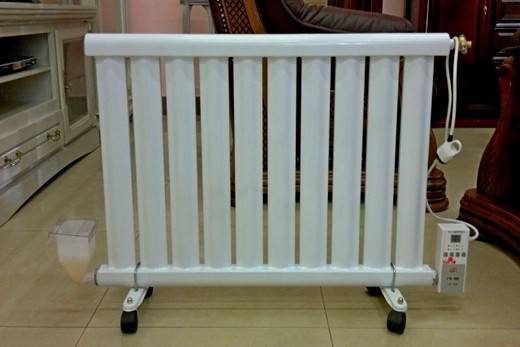

An electric vacuum radiator is a good option for economical heating
The set of heaters includes emergency shutdown sensors and temperature controllers. The positive aspects in the operation of vacuum radiators include:
- Ease of installation;
- No need for auxiliary equipment;
- Nice design;
- Autonomy;
- The ability to regulate the temperature in a wide range - 20-70 degrees C.
Attention! As a disadvantage, it should be noted that the vacuum battery cannot be tilted. It should stand on a perfectly flat surface.
How to calculate the required power and quantity
For heating 1 sq. m of living space needs from 80 to 100 W of thermal energy... Simple calculations show that for a room of 10 sq. m, a radiator with a capacity of 800-1000 watts is enough.More accurate calculations should take into account the standard coefficients for calculating heating radiators, which we have already written about in our reviews - this takes into account the ratio of windows and floors, the quality of thermal insulation, the structure of the windows, the climate features of the area, the number of external walls and much more.
Also, when choosing an electric heating radiator, you need to take into account the features of the equipment. For example, infrared radiators use less electricity to heat rooms.
Advantages and disadvantages
Oil-fired electric heating radiators have a number of positive qualities, including:
- Compactness. These batteries take up little space.
- Mobility. Most models, thanks to the castors, can be easily moved from room to room.
- Safety. The metal case does not heat up above + 60 ... + 70 ° C, which excludes the possibility of burns and injuries. All working elements heated to high temperatures are located inside the casing.
- Silence. Oil batteries do not make noise during operation (except for models equipped with fans).
- They do not dry out the air in the room, do not burn out oxygen and do not emit unpleasant odors (in comparison with devices with open heating elements).
- Affordable price.
- Ease of operation. You just need to plug the cord into an outlet and follow some simple rules.
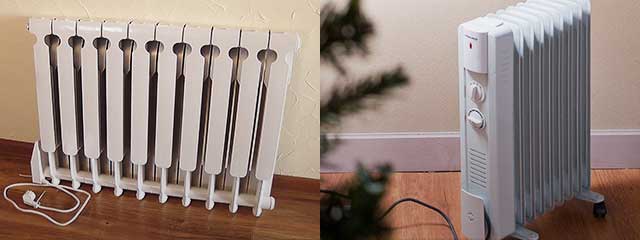

The disadvantages of such designs include the following qualities:
- Inertia. Mineral oil reaches its operating temperature for a long time (due to its high heat capacity) and the room heats up slowly. But the liquid does not cool down immediately, gradually giving off the accumulated heat.
- Quite large weight and dimensions, which is not always convenient. The disadvantage is compensated by the presence of wheels.
Convection radiators
The mass production of this type of heater began over a century ago. Outwardly, they resemble oil radiators, but their body is flatter. They have wall-mounted convector electric radiators, they are installed at a height of 10-15 cm from the floor. They can also be placed on the floor with casters or feet.
There are two grilles in the convector body. The first one is at the bottom, and is designed to capture cold air from the floor. The other grating is on top and occupies approximately 15-20% of the vertical surface. Inside there are heating elements, along their length there are metal plates. These plates increase the useful surface of the heating element. Electric heating elements for heating radiators are made of stainless steel. Magnesite is poured into the tubing of the heating element and sealed hermetically.
Convector heating batteries have a number of positive qualities.
- Does not require grounding.
- The outer surface heats up no higher than 65 degrees. While the tena can heat up to 1000 degrees.
- Control switch for shutdown when the device overheats.
- There are models for installation in rooms with high humidity.
- Reliability, ease of installation and use (service life from 15 years).
- Affordable price.
- Autonomous work, due to the electronic control panel.
- The efficiency is 95%.
- Convector radiators start heating the room immediately after switching on. The average heating speed of the heating element is about 30 seconds.
But with a large number of positive qualities of convector heating systems for rooms, they have a number of disadvantages.
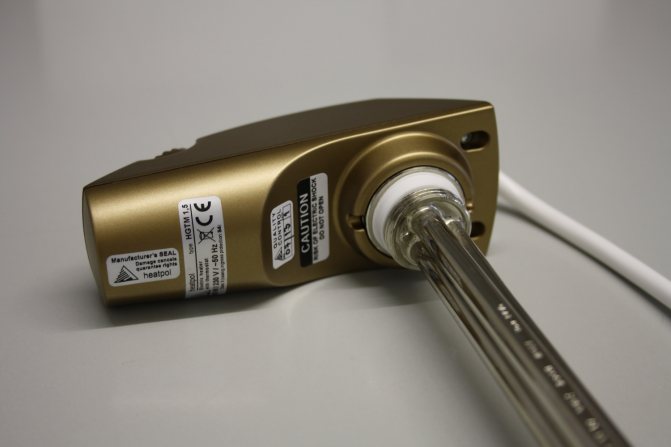

- High energy consumption.
- Heating large rooms with convector radiators is not rational.
- Efficiency decreases annually.
- Convector batteries dry the air and carry dust strongly.
Convection type devices
Convectors are electric heaters, which can be both wall-mounted and floor-mounted.Their principle of operation is based on the constant heating of cold air, which goes down in accordance with the laws of physics. These devices evenly warm up the room, but at the same time they do not burn oxygen in the same way as the older versions - heat fans.
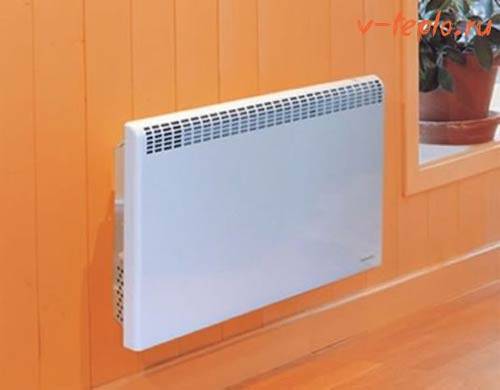

How does a wall mounted electric heater work?
Convection electric wall heaters include the body itself and the heating element itself. In the first, special holes have been made - cold masses enter the grilles located in the lower part, quickly warm up and leave the device through the upper blinds located on the front part.
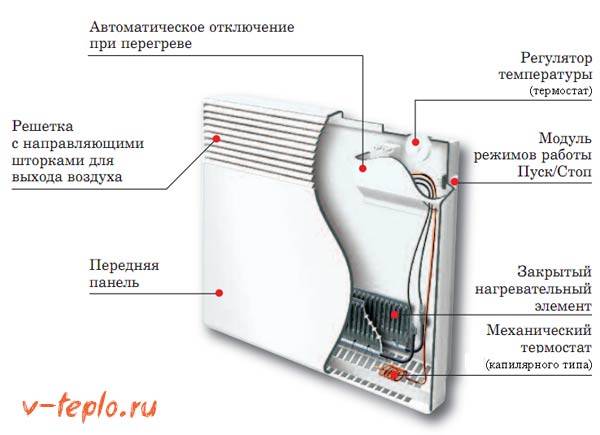

Recently, manufacturers are increasingly abandoning needles, giving preference to heating elements - such devices are more durable, they do not heat up so much, in addition, they can be used even in rooms where the level of humidity is high. Monolithic elements are elements of the case and are considered the most effective (moreover, they are the most silent and durable).
Note! Depending on the principle of operation, convectors can be of two types - active and passive. The former are equipped with a special forced fan, which increases the speed and efficiency of work.
Almost all modern convectors have a waterproof case, which is why they can be installed even in showers and bathrooms. Finally, the heating of the case often does not exceed 50-60 C, therefore, accidental burns are completely excluded.
The former are equipped with a special forced fan, which increases the speed and efficiency of work. Almost all modern convectors have a waterproof case, which is why they can be installed even in showers and bathrooms. Finally, the heating of the case often does not exceed 50-60 C, therefore, accidental burns are completely excluded.
Panel radiators
How to carry out the installation correctly, as well as the average prices for panel radiators in our detailed review, see here
Technical characteristics of convection appliances
When choosing a wall heater, you need to take into account the fact that their efficiency and performance depend on the power, and not on the dimensions of the case. And if the ceiling height is standard, then for every 10 m2 of area, 1 kW of equipment power is required
This is the most important indicator, but not the only one - attention should be paid to a number of others.
- Air humidification. A humidifier built into the appliance neutralizes the dryness of the air caused by the operation of an electric heater.
- Thermostat. It is necessary in order to regulate the heating temperature. More modern models are equipped with electric thermostats, which allow you to more accurately adjust the operation of the equipment.
- Ionizer. Another "trick" in which oxygen receives a negative charge, being under high voltage. This module is especially important for those consumers who really care about their own health.
- Timer. Another useful module that allows you to adjust the operating time of the equipment with the utmost simplicity.
- Remote control. A very convenient addition, with which you can instantly make adjustments to the settings without leaving the cozy sofa.
- Anti-freezing. This is a mode that automatically turns on the heater in the event of a critical drop in temperature. It is also very useful, especially in the country or in a private house, where they live inconstantly.
- Restart. The device automatically turns on with the preset settings. Triggered by a power outage.
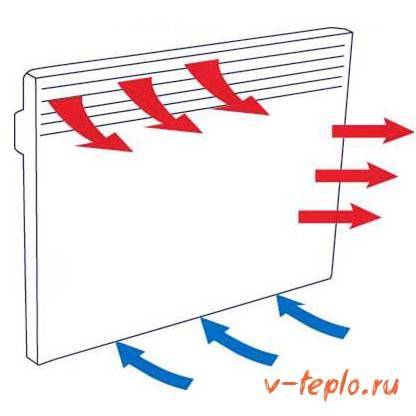

Types of wall batteries
There are several types of wall-mounted electric batteries that differ in their principle of operation.
Infrared
The principle of operation of infrared batteries is to convert electrical energy into thermal radiation. Long-wave radiation heats the floor and the objects on it, which serve as heat transmitters. Heating objects, rather than air, retains heat longer, allowing you to use energy economically.
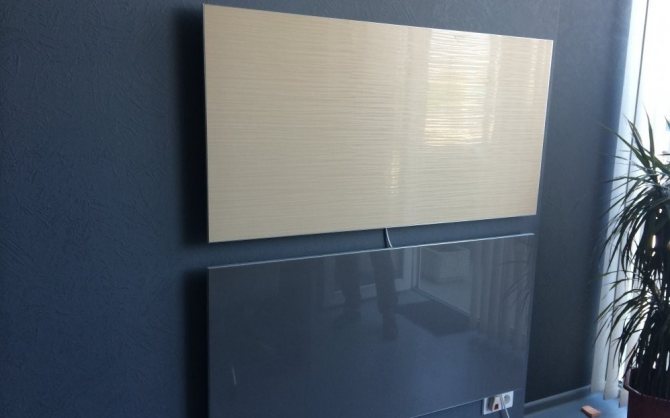

Convector
In electric convectors, heat is transferred by heating the air passing through the device. Warm air increases in volume and leaves through the grilles of the device, and cold air enters its place. Thus, the room warms up very quickly. It is important to prevent the presence of drafts so that the convector does not work uselessly.
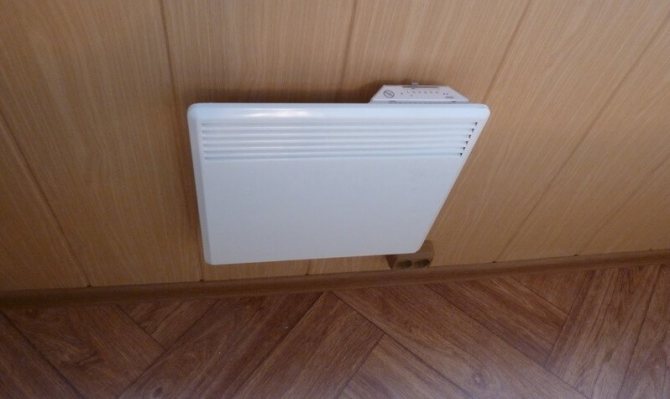

Electric wall convector prices
Electric wall convector
Oil radiator
The element inside the radiator heats up the intermediate heat carrier (mineral oil), which then heats up the unit body. The oil used keeps heat for a long time, thus saving energy costs. Oil radiators are cheaper than other types of heaters and have small dimensions. However, heaters of this type warm up a room rather slowly, especially a large one. The surface of the radiator heats up to 150 °, which requires careful handling of the device.
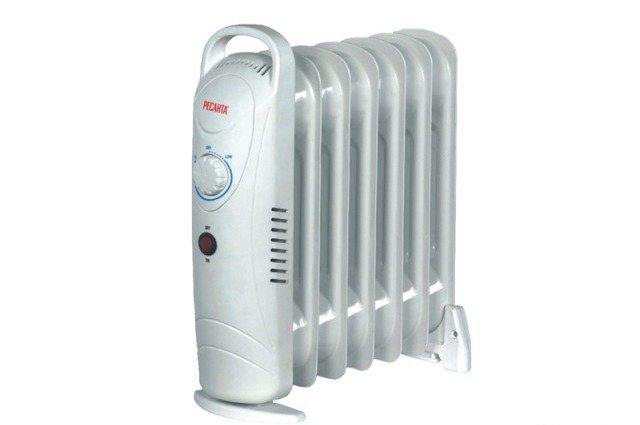

Fan heaters
The essence of fan heaters is to warm up the air flow that passes through the heating element. Air supply to the device is provided by a built-in fan. Most often, fan heaters are used in rooms where maintaining a constant temperature is not required. Many models can be used as a regular fan.
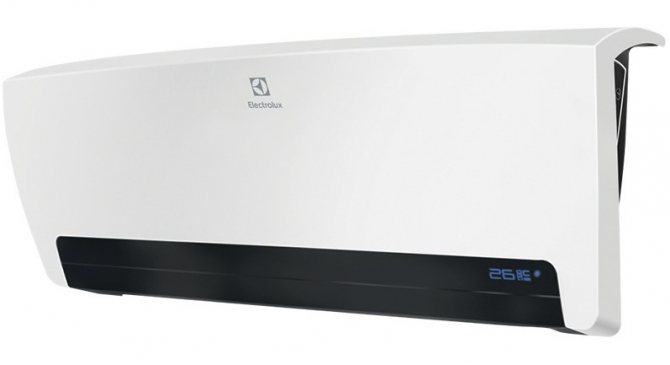

Electric fan heater prices
Electric fan heaters
Vapor-droplet heater
In the system of a para-droplet heater, there is water in an enclosed space, which is heated by electricity and turns into steam. Condensation then occurs and the water is returned back to the liquid carrier system. This principle of operation of the heater allows you to use two types of energy at once: from the coolant and from the condensation of steam. After turning off the power, the device retains heat for a long time.
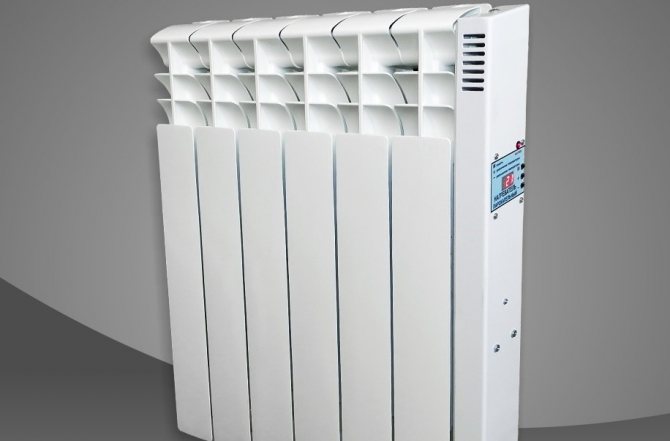

Carbon Heaters
Carbon fiber heaters use carbon fiber embedded in a quartz tube as a heater. This is a long-wavelength emitter that heats objects in the room, not the air.
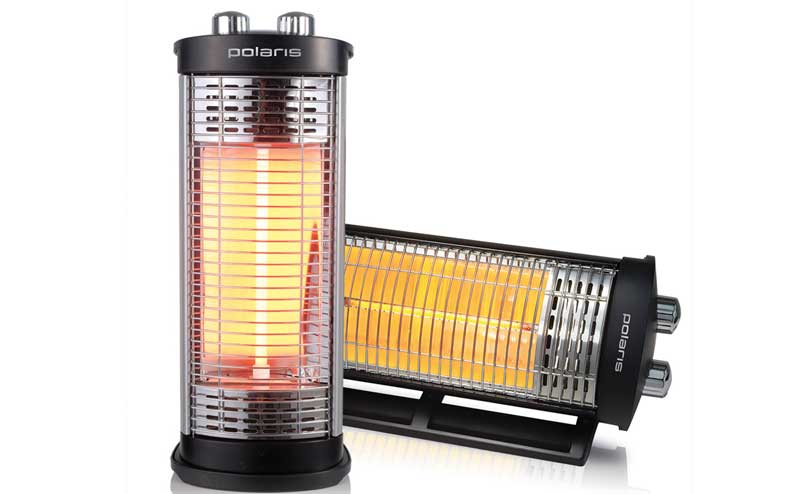

Lithium Bromide Heaters
The lithium bromide radiator consists of vacuum sections filled with lithium and bromide liquid, which turns into steam at 35 ° C. Steam rises to the top of the sections, giving off heat, and heats up the radiator.
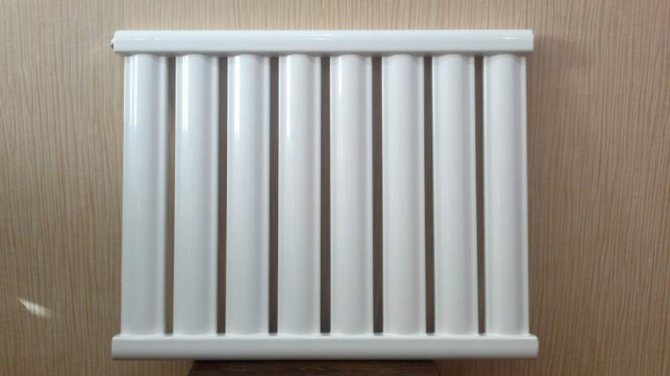

How to choose the perfect convector. Specialist recommendations
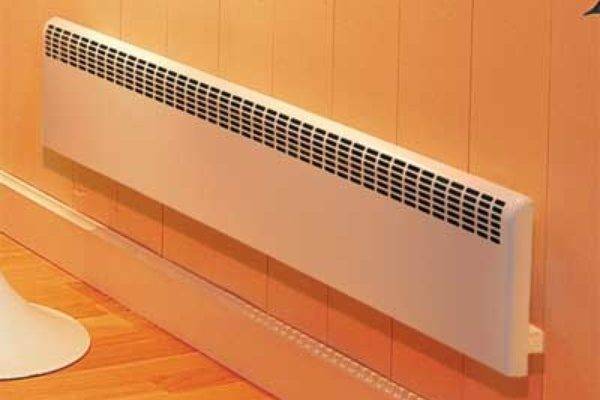

Needle heater radiator
Tip 2
When buying, pay attention to the heating element. The service life of the heating element is approximately 15 years.
This is already a lot for suburban buildings, but there are models with an even longer period. This is achieved with the help of better materials from which the body is made. Such heaters will be more expensive than conventional ones. However, it makes sense to buy them only for an apartment or private house. Tip 3. Electric convectors consist of several panels, each of which works autonomously. As a result, the structure heats up gradually. To correctly calculate the radiator power, you need to rely on the established standards for space heating: 100 W. power per 1 square meter of area. For example, for a room with an area of 20 sq. meters, you will need a unit with a power of 2000 watts. If the ceilings are high (from 3 m.), The capacity increases by 150%.
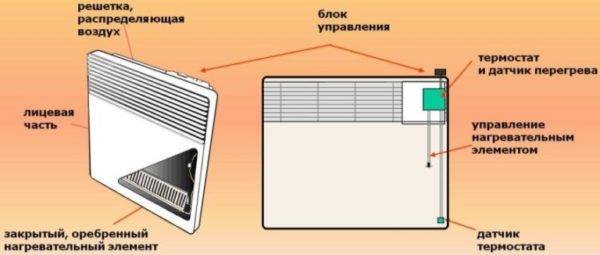

How the covector works
Tip 4.Wall mounted electric heaters require a separate power supply line from the switchboard. It is best to buy convectors with electronic thermostats. They are more sensitive to temperature fluctuations and instantly change the power of the radiator. There are heaters that allow you to program thermostats, but they are more expensive than conventional heaters. With the help of these devices (thermostats), you can program the device for different operating modes both at night and during the day.
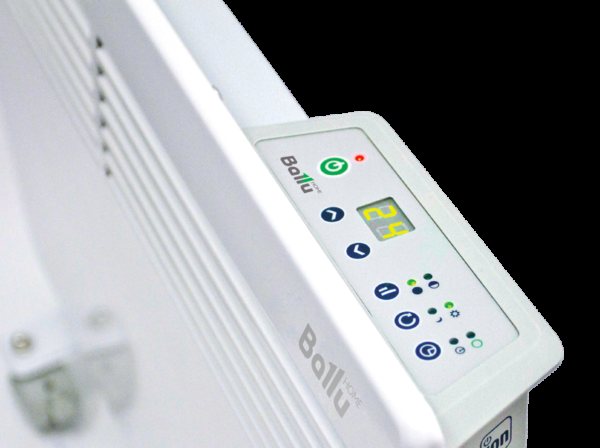

Convector with electronic thermostat
Tip 5. Choose radiators with legs, regardless of where you decide to install it: under the windowsill or on the wall. Sooner or later, it may be necessary to move the heating system to another room
Many modern batteries have a built-in rollover sensor, which is especially important if the family has children
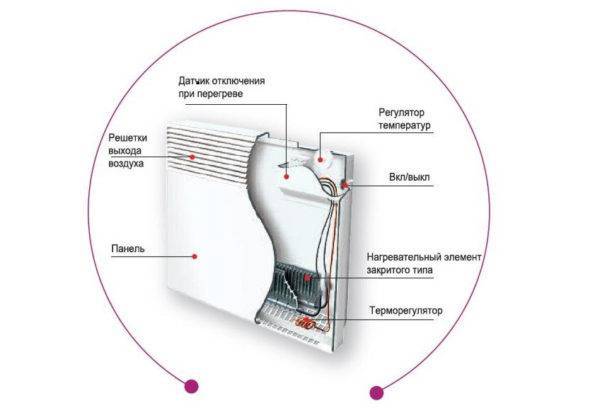

Convector structure diagram - built-in overturn sensor
Tip 6. The body is an important part of the convector. Its strength and size cannot be neglected. Quality electric heaters have a well-designed metal body for maximum heat dissipation. You should know that the thermal power of the radiator is increased by increasing the speed of air movement through the heating element. For urban dwellings, it is quite possible to do with a convector with a height of 40-60 cm, and lower models are also suitable for summer cottages - up to 40 cm.Consider that all modern electric convectors, both floor-standing and wall-mounted, are equipped with a double insulating layer to protect the heating parts, therefore, they do not need additional insulation.


Various versions of the housing of electric convectors.
Tip 7. Ukrainian-made convectors are one of the most inexpensive on the market. These models are equipped with needle heaters. Despite the fact that such radiators are cheaper, the level of their electrical protection leaves much to be desired. Is it worth the risk to save money? Definitely not, even if you just come to the house for a few months. Safety is always important. Models from European manufacturers are more durable, and the heating element is a nichrome thread hidden in a steel quartz tube. The temperature of such heating systems is not too high, but European electric heaters are more durable and less capricious in use. Tip 8
Pay attention to the radiator fins. The most optimal option is 0.6-0.8 m 2 / kW
You can find the necessary data in the data sheet of the convector or on the official websites of the manufacturers, where complete information about the product is indicated. The efficiency of the device directly depends on its heating area. However, do not overpay for what you are not going to use. Too powerful a convector is more likely to lead to a waste of money and a hot indoor climate. Therefore, before buying, it is better to measure the area of the rooms where the heating will be.
What is the best way to choose a radiator for a particular room?
On average, the rated power of one section is 0.13 kW. The required number of sections is selected depending on the area of the room according to Table 1. The data presented in the table are relevant for city apartments located in an insulated apartment building. If the room is located at the corner of the building, or the house is poorly insulated, the recommended number of sections must be looked at 1-2 lines below the indicated area of the room.
Table 1 - Selection of an electric radiator depending on the area of the room
| Room area, m2 | Recommended number of sections | Rated power, kW | Electricity consumption, kW / hour |
| less than 4 | 3 | 0,39 | 0,10 |
| from 4 to 6 | 4 | 0,52 | 0,15 |
| from 6 to 8 | 5 | 0,65 | 0,20 |
| from 8 to 10 | 6 | 0,78 | 0,25 |
| from 10 to 12 | 7 | 0,91 | 0,30 |
| from 12 to 14 | 8 | 1,04 | 0,35 |
| from 14 to 16 | 9 | 1,17 | 0,40 |
| from 16 to 18 | 10 | 1,30 | 0,45 |
| from 18 to 20 | 11 | 1,43 | 0,50 |
| from 20 to 22 | 12 | 1,56 | 0,55 |
If the area of the room exceeds 22 meters, two or three radiators are required to heat it.It is also recommended to increase the number of radiators if there is more than one window in the room. In this case, the heating devices installed under each window create a thermal curtain, reducing the outflow of heat outside the room.
Pros and cons of convectors
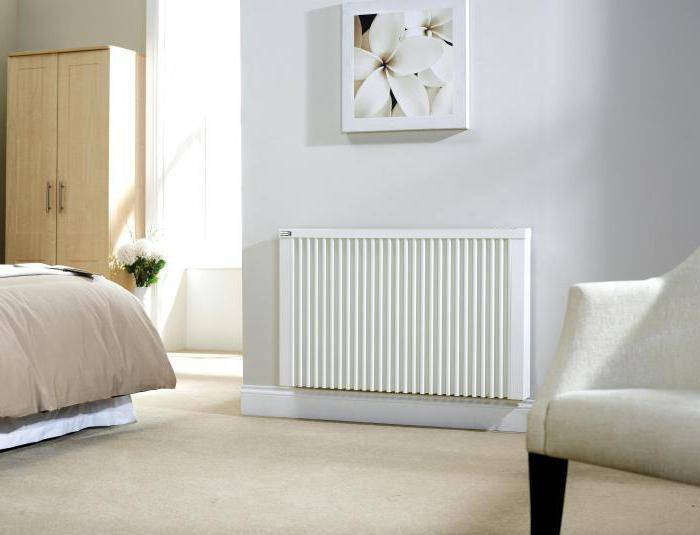

If you like an electric wall-mounted radiator more than others, then you should consider a convector, the principle of which is based on the laws of physics. As you know, cold air goes down, and here the equipment absorbs flows into the lower grate. As they pass through the heating element, the temperature rises, the air becomes lighter and rises towards the ceiling. The convection cycle will repeat itself over and over again, and the continuous movement of air will create a comfortable indoor temperature.
Such a wall-mounted electric radiator has heating elements and a metal body. The devices are supplemented with special timers, as well as automatic controlled thermostats. The convector does not burn oxygen, does not dry out the air, is safe, easy to install and does not require human control. The only drawback may be the lack of a suitable place for installation.
Key characteristics of electronic heating convectors
According to the method of installation and fastening, electric convectors are divided into two types:
Wall-mounted models have a height of about 45 cm, and floor-standing ones have a maximum of 20 cm. Also, narrow and elongated floor-standing radiators have high efficiency due to the fact that heat exchange with the medium occurs over their entire area.
However, along with this, wall-mounted radiators have a simpler design.
The key characteristics of electric convectors are as follows:
- if the radiator has an automatic control function, it does not need to be monitored additionally;
- when the convector is in operation, the air heats up quickly and there are no drafts;
- built-in thermostat allows you to control the temperature and save energy;
- automatic control devices prevent the structure from overheating. you can also install the radiator on a surface made of any material;
- availability of special protection against moisture;
- the maximum heating temperature of the structure body is 65 degrees, so there is no risk of injury from contact with it;
- modern ergonomic design, no sharp corners, safe use and the ability to install even in a children's bedroom;
- when heated, the air does not acquire an unpleasant odor;
- lack of forced ventilation, so the radiator works silently.
Also on sale you can find models of wall-mounted electric radiators, which, in addition to wall mounts, are equipped with removable castors or rollers. Such a heating device can be easily installed on the wall and also easily removed from it to be installed anywhere in the room. If the electric convector has a design that is suitable only for stationary installation, then the place where it will stand must be thought out accurately and in advance so that the design does not interfere in the future and can heat the entire room.
Each model of electric heating radiator has a different average life. Basically, this term depends on how high the quality of the heating element is. For example, a heating element made in accordance with all norms and rules can work without problems for about 15 years or even longer.
At the same time, manufacturers generally indicate the warranty period of the product at least 2 years. The heating element must be in a steel case, the quality of the metal must be excellent, withstand high temperatures, much higher than the temperature of the heating element during maximum hardening.
Remember that although the electrical system of such heating devices is quite simple, it is not worth assembling them with your own hands, even if you have experience in this area. An improperly assembled and running self-made installation can lead to a fire.
Advantages of electric batteries for heating a private house
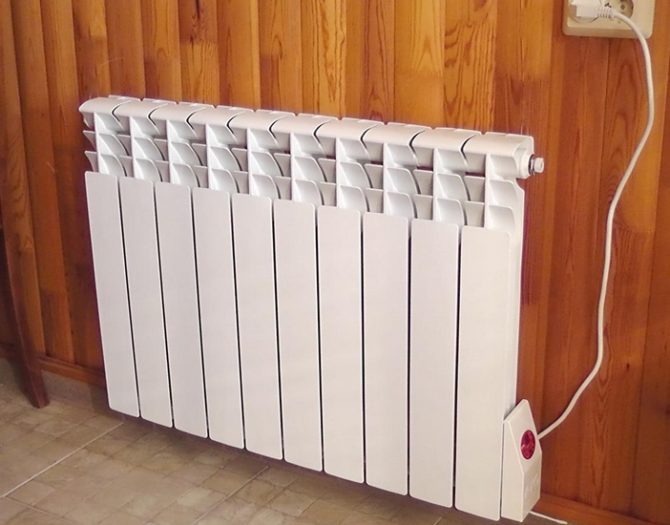

To install electric radiators, it is necessary to carry out high-quality wiring in the apartment.
There are at least seven reasons to pay attention to a heating system assembled from current-powered elements:
- Ease of project implementation - you do not need to have special skills to attach an electric radiator to the wall and plug it into an outlet. There are no additional elements, only high-quality wiring is needed.
- Environmental friendliness - during the operation of the device there is no emission of harmful substances, the combustion process does not occur.
- A wide selection of heaters - the homeowner can choose the best option for his area, the quality of wall insulation, and other criteria.
- Modern units are equipped with electronic control systems and work in tandem with thermostats or the “Smart Home” system.
- There are special reduced tariffs for electric heating for the population, which allow additional savings.
- Almost all batteries warm up quickly, you do not need to wait long for the room to be warm.
- The appearance of the convectors is highly decorative and fits perfectly into any interior of the house.
The gradual transition to alternative and renewable sources of electrical energy predictably leads to a reduction in the cost of the latter.
Oil radiators
There are many models of heaters on the market.
Oil-fired electric heating radiators are popular among consumers and occupy the lion's share of the market. Externally, the electric oil cooler resembles a classic finned water battery. The internal structure has a lot in common with water radiators: mineral oil is used as a heat carrier, heated with a heating element. The heat is transferred to the finned housing and spreads through the room by means of thermal radiation. The number of sections (fins that increase the heat transfer area) ranges from 5 to 12 for different models, and the power of the devices ranges from 500 W to 3 kW. The dimensions of the oil coolers may vary. For ease of movement, the product is equipped with wheels.
In addition to finned ones, models in a one-piece case are available. Such devices consist of one, two or three smooth panels, heating elements in heating radiators are built into the lower part of the panels. Manufacturers offer floor-standing and wall-mounted devices. The panel wall-mounted electric oil radiator is installed in any convenient place, including under the window opening, and outwardly practically does not differ from a water heating radiator.
The wiring diagram of the oil cooler provides for automatic shutdown in case of overheating of the heating element or oil leak. There are models of devices on the market with additional features: smooth temperature control, switching heating modes, built-in ionizer, air humidifier, clothes dryer or an electronic programmer.
Oil-fired electric batteries are quiet, easy to operate and safe. The disadvantages include inertia (it takes time to warm up the oil) and a high surface temperature during heating.
How the radiator works
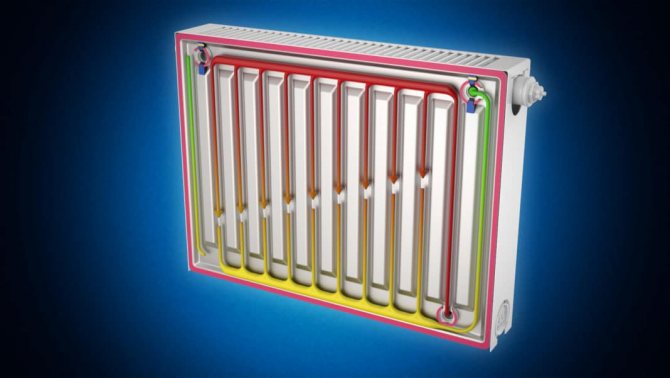

Radiator circuit
An electric heater will serve as the easiest way to maintain the desired temperature in the apartment. For the operation of this device, the main condition is to provide a source of electrical power (the power of this source must be sufficient).
The main components of an electric heater are:
- the case (it has an external resemblance to a sectional battery), its function is that it accumulates the heat of the heater and transfers the received heat to the air of the room
- a heater (heating element is more often used, a special tubular electric heater), consuming electrical energy, it heats up.
For the correct choice of a heating radiator for each individual apartment, you need to know which type is best suited, how many sections are needed to obtain a sufficient amount of heat, as well as the type of coolant. It is important, when choosing an electric radiator, to pay special attention to the completeness of the device with the necessary parts. The control unit must be functional and practical.
Types of electric heaters
The classification of electric heaters is mainly related to the nature of heat transfer. On this basis, there are:
- fan heaters
- convectors
- oil heaters
- infrared heaters
Fan heater
This is an electric heating device, conditionally consisting of two parts - a heater and a fan. The principle of its operation consists in pumping air by a fan through a heating chamber or a heating element. The heated air, "driven" by the fan, leaves the device at a certain speed and therefore spreads faster and more efficiently throughout the room. Heating elements can be various spirals, flat devices or heating elements - tubular heaters.
The device is equipped with a thermostat that turns it off when the set temperature is reached. In addition, it can include a fan speed controller and a timer to set the operating time. This allows you to avoid overheating during long-term operation.
Convectors
Sectional convector
In them, the transfer of heat is based on the phenomenon of convection. Convection is understood as the mixing of layers, gases or liquids with different temperatures as a result of the influence of the earth's gravity on them.
Simply put - warmer and lighter air rises up, while colder and heavier air goes down. It turns out a kind of closed circle, in the center of which there is an electric radiator. Air moves around it. As it heats up, it rises up, and when it cools down, it goes down to the radiator, and the whole cycle repeats.
These devices have automatic thermostats and timers. Water heating radiators work according to the same principle.
Oil heaters
In these devices, the working fluid is oil. Such devices do not have open heating elements, so oxygen and fine dust particles are not burned.
In addition, the oil has a high boiling point. Therefore, unlike water, it does not boil. All this together makes the use of oil-filled electric heaters absolutely safe. All devices have standard controls and automation.
Infrared heaters
These are devices that do not heat the air, as in other cases, but the surrounding objects. This happens due to electromagnetic waves of a certain frequency. Surprisingly, the device itself remains absolutely cold.
This is still a fairly new type of heating, but its use is becoming more widespread.
Choosing an electric boiler
Before buying an electric heating boiler for a private house, you need to analyze various parameters and characteristics in order to choose a model with a good value for money. First of all, you need to take into account the size of the heated room - this factor is very important when choosing the boiler power (of course, you need to pay attention to the size of the unit).
Try to decide in advance on the place of installation of the boiler in order to make all the necessary measurements.Having familiarized yourself with the characteristics of suitable models, which are spelled out in the passport - instructions, you can choose an electric heating boiler for your home that is suitable for its properties and cost.
People who, to put it mildly, are poorly versed in the topic, a natural question arises, which is how best to choose such heating radiators without making a mistake? An indisputably important factor in this matter is that it is much easier and easier to achieve the required shape from aluminum analogs, even at the production stage.
Since the use of district heating is often associated with high pressure levels and low purity of the coolant, radiators made of aluminum and steel are truly the most reasonable solution.
It is these radiators that are able to withstand pressure, which will be in the bordering range with respect to forty atmospheres - a critical indicator.
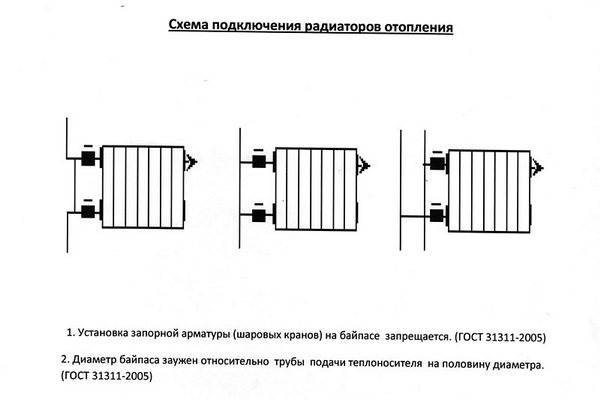

Oil for oil heater
The question of what kind of oil is in the heater does not often have to be decided, since these devices are always hermetically sealed to prevent evaporation and leakage of the working substance. During operation, replacement is extremely rare.
If there is a depressurization, then it will not be enough to add oil, first you need to repair the case and solder the leak. After restoring the tightness and in the presence of a technological hole for filling liquid, it is possible to refuel or change the oil.
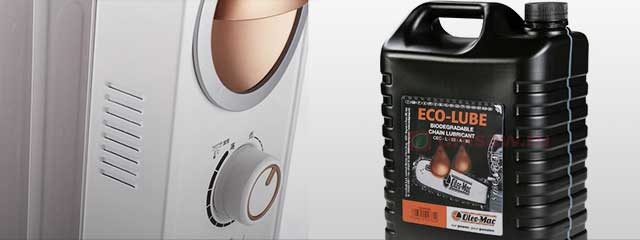

Various transformer, mineral automobile (transmission) oils and sometimes even waste oils can be poured into the oil heater.
It is important to remember that oils of different origins must not be mixed in the radiator, since
an unpleasant reaction may occur (a precipitate will form, the composition will thicken, etc.). Topping up is allowed only a substance identical in composition. It is not recommended to do this on your own. It is better to carry out repair work in specialized service centers.
Advantages and disadvantages of oil heaters
Among electric heating devices, oil ones are the only ones called electric radiators. Oil heating has a lot of advantages:
- does not dry the air;
- radiators transfer heat mainly by means of thermal radiation;
- has a safe design;
- the surface almost never heats up above 50-60 o C;
- easy installation and management.
All this is true, but there are also disadvantages. The main thing is a sufficiently large inertia. The oil, which is used to transfer heat, has a high heat capacity. And until it heats up, the air will not start to warm up. But this same property allows you to smooth out temperature differences when enabled / disabled.
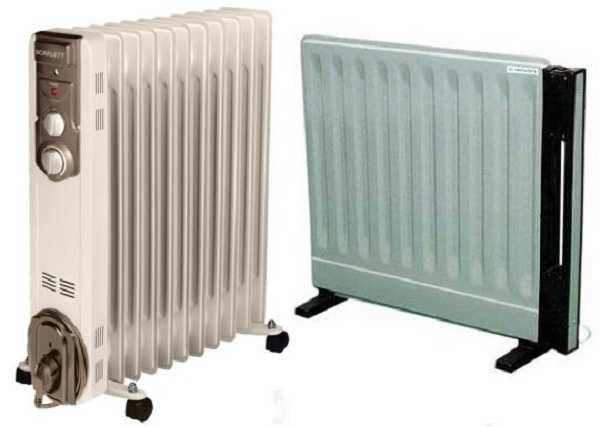

The biggest problem is high inertia and low efficiency: too many stages of heat transfer
The second disadvantage is that the safety and durability of work depends on the quality of workmanship. An incorrectly calculated design can simply burst when heated, poorly sealed seams, and oil will flow. Therefore, buying cheap, but unknown brands is a risky business.
How does an oil-fired electric heater work?
Mineral oil has a higher heat transfer than water, therefore it is used as a heat carrier in a heater.
The principle of operation of the heating device is as follows:
- Heat carrier - oil is poured into oil coolers. To increase heat transfer, only mineral technical compositions with a certain viscosity are used.
- Heating element - a heating element is used in the design, placed in a sealed case. Heating elements do not come into direct contact with oil, which ensures maximum operational safety.
- Control devices - the first models were equipped with the simplest mechanical thermostats.Modern systems used for continuous heating are equipped with several sensors to prevent overheating of the oil and housing, and an electronically controlled temperature controller. In case of an accidental fall of the heater, the power supply is automatically cut off.
- Case - manufactured in explosion-proof design. Some models have convection ducts and look like aluminum radiators.
The heating element heats the oil to a certain temperature. Good heat transfer allows you to evenly warm up the coolant. The oil is heated according to the indirect heating principle. Direct contact with the heating element is excluded.
To ensure comfortable and safe operation, all modern models use the so-called protection against "fools". Special sensors monitor the overheating of the surface of the case, accidental overturning of the device. If someone decides to dry things on the radiator (which cannot be done), the system will simply turn off the heater.
Installation of bimetallic radiators
Let's move on to the issue of installing radiators. Installation of bimetal (no matter how tired the installers are) is by no means the most difficult thing. During the installation process, it is very important to observe the distance between the walls, which is approximately equal to three centimeters - the same can be said about the distance from the window sill to the floor (from ten centimeters or more).
For the installation of a bimetallic radiator, it will be necessary to purchase brackets, adapters, gaskets, plugs, taps for draining water. During installation, care must be taken to ensure that the aluminum layer remains intact.
Bimetallic radiators are distinguished by their lightness - despite their bulkiness, the mass of one section does not exceed two to three kilograms, which greatly simplifies the installation processes.
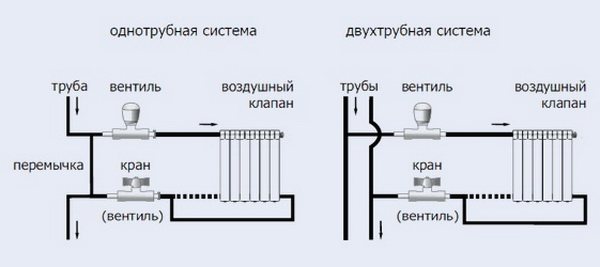

Pros and cons
Wall mounted electric economical heating radiators for summer cottages will delight you with the following positive qualities:
Advantages
- A wide range of. Specialized stores can offer you a huge variety of options to choose from, differing in the number of sections, colors and dimensions. The most powerful designs with 12 sections also have a high efficiency.
- Attractive appearance. Any wall-mounted electric radiator will perfectly fit into the design of a modern apartment, in addition, there are design models that are distinguished by special beauty and originality.
- Elementary installation instructions. The only thing you need to be able to do in this case is to drill holes in the walls, which are necessary for mounting the hooks on which the radiator itself is hung.
- High level of fire safety. The heating elements of the units under consideration do not come into contact with the rest of the components, which excludes the possibility of spontaneous ignition.
- Programming. One of the most striking advantages of electric radiators is the ability to fully automate the operation of the heating system. You can set the timer on and off the device, set the cycle of its operation and set a comfortable temperature for heating the air in the room.
- Minimum installation requirements. Just one socket is enough, which is simply ideal, for example, for country houses, to which it is sometimes impossible to connect a gas main, but there is electricity.
- Lack of air burning and drying effect. Arrangement of forced ventilation and use of humidifiers is not required.
- The presence of automatic protection that does not allow overheating.
- Low heating level of the case, excluding the possibility of getting burned.
Disadvantage
The only significant drawback that can be identified is the high price of electricity.But you can always set up an economical operating mode for the operation of your electric heating system, besides, there is no need for expensive piping and installation of ventilation, which also allows you to significantly reduce overall costs.
Wall mounted electric radiators are as follows:
Option number 1: oil
The principle of operation of such heaters is to use a heat transfer oil, the temperature of which rises due to the operation of a special electric heating element. From the oil, the case heats up, and from it the air surrounding the device.
It is noteworthy that the boiling point of oil is much higher than that of water, this significantly increases the possibility of heating it, and, consequently, productivity. Such units also have all the necessary set of automation.
| Designation in the diagram | Name |
| 1 | Housing |
| 2 | A pen |
| 3 | Panel |
| 4 | Thermostat |
| 5 | Switch |
| 6 | Cap |
| 7 | Coil |
| 8 | Power cord |
There are both classic horizontal and more original vertical models. It is also worth noting that water can sometimes be the basis of the coolant in heaters of this class.
Option number 2: infrared
The main feature of such an apparatus is that it heats not the air, but directly the object itself, which greatly increases the efficiency of its work. Thus, although the equipment itself is not cheap, its operation is quite economical.
| Designation in the figure | Name |
| 1 | Fastening |
| 2 | Metal case |
| 3 | Heating element |
| 4 | Ceramic hob |
(no votes yet)
Using electric radiators
It is generally believed that electric heating systems are more expensive to operate than our usual gas heating systems. This is due to constantly increasing resource prices. However, there are electric batteries for economical heating. In addition, it happens that electric radiators are the only way out, since gas is supplied to consumers with interruptions, or the gas main does not pass in the area at all.
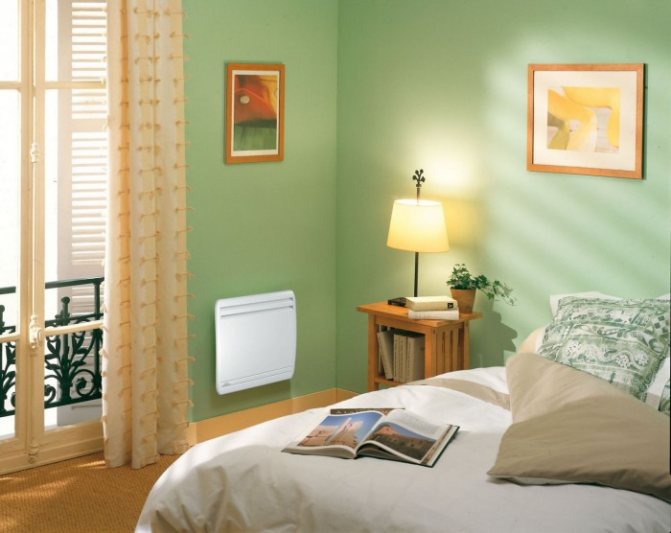

Electric convectors can be installed anywhere
It is worth noting that recently, electrical heating devices have been used only as additional or backup heating.
So, a heating scheme can be done classically when the heating uses water. So, not special electric energy-saving heating radiators are used, but the most common radiator with water. In the second scheme, the boiler may not be, there will also be no water and a water main. There will be only an electric heater. The device itself can be permanently attached to a specific place or it can be moved depending on the requirements of the home owners.
How to choose electric convectors?

